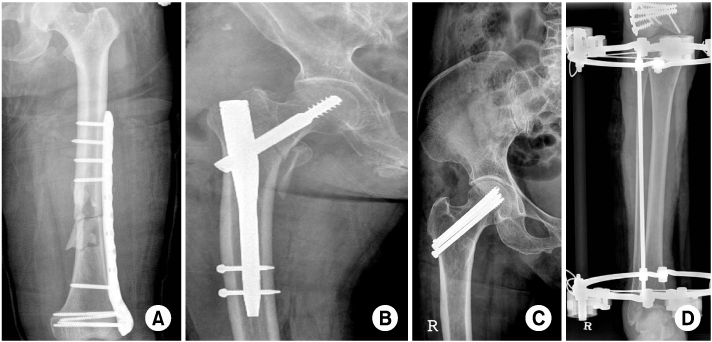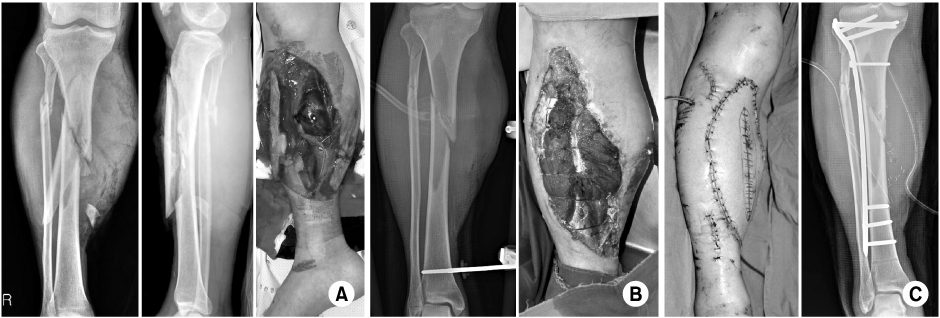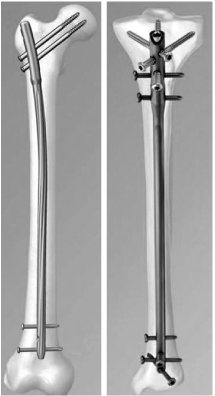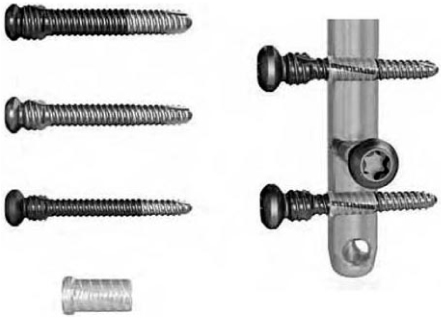J Korean Fract Soc.
2013 Jan;26(1):81-91. 10.12671/jkfs.2013.26.1.81.
Updated Basic Principles of Internal Fixation of Fracture
- Affiliations
-
- 1Department of Orthopedic Surgery, Yeungnam University Medical Center, Daegu, Korea. ossoj@med.yu.ac.kr
- 2Department of Orthopaedic Surgery, Inje University Haeundae Paik Hospital, Inje University College of Medicine, Busan, Korea.
- KMID: 1431724
- DOI: http://doi.org/10.12671/jkfs.2013.26.1.81
Abstract
- No abstract available.
Figure
Cited by 1 articles
-
Comparison of Greater Trochanter Versus Piriformis Entry Nail for Treatment of Femur Shaft Fracture
Jong-Hee Lee, Jong-Hoon Park, Si-Yeong Park, Seong-Cheol Park, Seung-Beom Han
J Korean Fract Soc. 2014;27(4):287-293. doi: 10.12671/jkfs.2014.27.4.287.
Reference
-
1. Aguila AZ, Manos JM, Orlansky AS, Todhunter RJ, Trotter EJ, Van der Meulen MC. In vitro biomechanical comparison of limited contat dynamic compression plate and locking compression plate. Vet Comp Orthop Traumatol. 2005. 18:220–226.
Article2. Ahmad M, Nanda R, Bajwa AS, Candal-Couto J, Green S, Hui AC. Biomechanical testing of the locking compression plate: when does the distance between bone and implant significantly reduce construct stability? Injury. 2007. 38:358–364.
Article3. Bagby GW, Janes JM. The effect of compression on the rate of fracture healing using a special plate. Am J Surg. 1958. 95:761–771.
Article4. Baumgaertel F, Buhl M, Rahn BA. Fracture healing in biological plate osteosynthesis. Injury. 1998. 29:Suppl 3. C3–C6.
Article5. Cheal EJ, Mansmann KA, DiGioia AM 3rd, Hayes WC, Perren SM. Role of interfragmentary strain in fracture healing: ovine model of a healing osteotomy. J Orthop Res. 1991. 9:131–142.
Article6. Danis R. Théorie et pratique de l'ostéosynthése. Paris: Masson;1949.7. Eggers GW. Internal contact splint. J Bone Joint Surg Am. 1948. 30A:40–52.
Article8. Egol KA, Kubiak EN, Fulkerson E, Kummer FJ, Koval KJ. Biomechanics of locked plates and screws. J Orthop Trauma. 2004. 18:488–493.
Article9. Frigg R. Development of the locking compression plate. Injury. 2003. 34:Suppl 2. B6–B10.
Article10. Gautier E, Perren SM. Limited contact dynamic compression plate (LC-DCP)-biomechanical research as basis to new plate design. Orthopade. 1992. 21:11–23.11. Gautier E, Sommer C. Guidelines for the clinical application of the LCP. Injury. 2003. 34:Suppl 2. B63–B76.
Article12. Gerber C, Mast JW, Ganz R. Biological internal fixation of fractures. Arch Orthop Trauma Surg. 1990. 109:295–303.
Article13. Goodship AE, Kenwright J. The influence of induced micromovement upon the healing of experimental tibial fractures. J Bone Joint Surg Br. 1985. 67:650–655.
Article14. Kowalski MJ, Schemitsch EH, Harrington RM, Chapman JR, Swiontkowski MF. A comparative biomechanical evaluation of a noncontacting plate and currently used devices for tibial fixation. J Trauma. 1996. 40:5–9.
Article15. Krettek C, Miclau T, Grün O, Schandelmaier P, Tscherne H. Intraoperative control of axes, rotation and length in femoral and tibial fractures. Technical note. Injury. 1998. 29:Suppl 3. C29–C39.
Article16. Kubiak EN, Fulkerson E, Strauss E, Egol KA. The evolution of locked plates. J Bone Joint Surg Am. 2006. 88:Suppl 4. 189–200.
Article17. Lambotte A. Technique et indication des prothéses dans le traitement des fractures. Presse Med. 1909. 17:321.18. Lane WA. Some remarks on the treatment of fractures. Br Med J. 1895. 1:861–863.
Article19. Laurence M, Freeman MA, Swanson SA. Engineering considerations in the internal fixation of fractures of the tibial shaft. J Bone Joint Surg Br. 1969. 51:754–768.
Article20. Mast J, Jakob R, Ganz R. Planning and reduction technique in fracture surgery. 1989. Berlin; New York: Springer-Verlag;xiii. 254.21. Müller M, Allgöwer M, Willenegger H. Compression fixation with plates. Technique of internal fixation of fractures. 1965. Berlin: Springer;47–51.22. Niemeyer P, Südkamp NP. Principles and clinical application of the locking compression plate (LCP). Acta Chir Orthop Traumatol Cech. 2006. 73:221–228.23. Perren SM. The concept of biological plating using the limited contact-dynamic compression plate (LC-DCP). Scientific background, design and application. Injury. 1991. 22:Suppl 1. 1–41.
Article24. Perren SM. Evolution and rationale of locked internal fixator technology. Introductory remarks. Injury. 2001. 32:Suppl 2. B3–B9.25. Perren SM. Evolution of the internal fixation of long bone fractures. The scientific basis of biological internal fixation: choosing a new balance between stability and biology. J Bone Joint Surg Br. 2002. 84:1093–1110.26. Rahn BA, Gallinaro P, Baltensperger A, Perren SM. Primary bone healing. An experimental study in the rabbit. J Bone Joint Surg Am. 1971. 53:783–786.27. Rozbruch SR, Müller U, Gautier E, Ganz R. The evolution of femoral shaft plating technique. Clin Orthop Relat Res. 1998. (354):195–208.
Article28. Ruedi TP, Murphy MW. AO principles of fracture management. 2000. 1st ed. Stuttgart; New York: Thieme;7–31. 139–155. 169–184. 195–218. 221–230. 249–253. 290–305.29. Schatzker J. Changes in the AO/ASIF principles and methods. Injury. 1995. 26:Suppl 2. 51–56.
Article30. Stoffel K, Dieter U, Stachowiak G, Gächter A, Kuster MS. Biomechanical testing of the LCP-how can stability in locked internal fixators be controlled? Injury. 2003. 34:Suppl 2. B11–B19.31. Tepic S, Perren S. The biomechanics of the PC-Fix internal fixator. Injury. 1995. 26:Suppl 2. 5–10.
Article32. Tong GO, Bavonratanavech S. AO manual of fracture management. Minimally invasive plate osteosynthesis (MIPO). 2007. 1st ed. Stuttgart: Thieme;3–45. 66–118. 305–325.33. Von Recum J, Wendl K, Vock B, Grützner PA, Franke J. Intraoperative 3D C-arm imaging. State of the art. Unfallchirurg. 2012. 115:196–201.34. Wagner M. General principles for the clinical use of the LCP. Injury. 2003. 34:Suppl 2. B31–B42.
Article
- Full Text Links
- Actions
-
Cited
- CITED
-
- Close
- Share
- Similar articles
-
- Open Reduction and Internal Fixation in a Displaced, Comminuted Acetabular Fracture: Report of a Case
- Management of Open Fractures
- A Review of Subbrow Approach in the Management of Non-Complicated Anterior Table Frontal Sinus Fracture
- Importance of maintenance medial buttress in treatment of supra-condylar and inter-condylar(T-condylar) fracture of the femur
- Subcapital Stress Fracture of the Femur after Internal Fixation of Intertrochanteric Fracture: A case report












